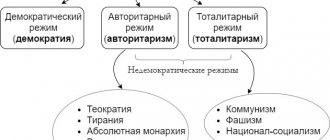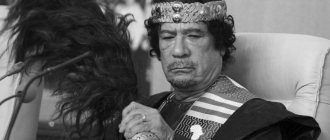In any society there are people who violate the norms of society, go against the rules and moral principles. In this article we will understand what deviant behavior means and what are the reasons for its occurrence.
Deviant behavior is human behavior that deviates from generally accepted norms of society. This behavior differs from the generally accepted one in its motives, values, ideals and means of achieving one’s own goals.
For example, such people may not say hello when meeting, have an “interesting” appearance, act out, or take innovative or revolutionary actions. Young people, saints and geniuses, revolutionaries and mentally ill individuals are most susceptible to this behavior. The behavior of such people, to one degree or another, disrupts the stability of social relationships in the family, on the street, in the team and in society as a whole.
You need to understand that deviant behavior may be the norm for one society or social group, but a deviation for another. It can also be positive and negative.
T. Parsons identifies two types of deviant behavior depending on a person’s attitude towards other people:
- The first type of personality seeks to dominate and subjugate people. This is a manifestation of deviant motivation, which is often observed in criminal gangs.
- The second type of personality submits to other people, makes concessions, or adapts to stronger and more active individuals. So, for example, a whole deviant society was formed under the leadership of Stalin.
There is a broader classification of such behavior developed by Merton. The typology is based on a person’s attitude to standards, their values, and needs. He identified the following types of deviant behavior:
- Total conformism (normal behavior) . This is a person who accepts the norms of society, gets an education, has a job, moves forward, thereby realizing both his own and social needs.
- Innovators are people who agree with the goals of their activities, which are approved by society, but at the same time do not follow generally accepted means of achieving goals. They come up with new and innovative means of achieving goals. For example, these are people who engaged in the privatization of state property, the construction of financial “pyramids”, and “racketeering”. This is precisely the type of deviant behavior that often has a positive connotation. These are the engines of progress.
- Ritualists are people who take the norms and principles of society to the point of absurdity. They demand compliance with all written rules and often go on strike.
- Retreatism means escape from reality. These are people who reject goals and ways to achieve them. This includes homeless people. Alcoholics, drug addicts, monks.
- Revolutionaries are people who reject outdated goals and replace them with new ones.
As can be seen from the above, deviant behavior also has positive manifestations. Thanks to revolutionaries and innovators, society abandons outdated values and goals and moves forward.
Deviant behavior and its causes, types, functions
Deviant (deviant) behavior is the motivational actions of an individual, which are fundamentally different from generally accepted values and rules of behavior in society, formed in a given culture or state.
It is represented by a social phenomenon that is reflected in mass forms of life and does not correspond to generally accepted rules of behavior. The criteria for deviant behavior are represented by moral and legal regulations. Delinquent behavior is represented by criminal behavior, which refers to illegal acts.
Symbolic interaction
This approach explains how people define deviations in everyday situations. Labeling theory states that deviance and norm are not the result of what we do, but rather the reactions of other people. Within this theory, there is a primary and secondary deviation. Primary deviance refers to going through episodes of deviant behavior in which most people engage. The second is when someone does something inappropriate and receives a negative social label that changes the person's self-esteem and social identity.
To demonstrate labeling theory, imagine two 16-year-old girls. Both are good students, athletes and have never been in trouble with the law. Let's say both girls decide to have a few drinks with their friends on the weekend or during school breaks. This will be the primary deviation.
Let's assume that one of the girls gets caught. She is registered with an educational institution, kicked out of sports, sent to alcohol counseling, called to school with her parents, and so on. Both girls committed the deviant act, the difference is that one of them was caught and the other was lucky. Secondary deviation is the same as primary, only in the second case the bad behavior was not noticed.
Types of deviant behavior
- The primary stage of deviation is when a person allows himself to violate generally accepted norms of behavior, but does not consider himself a violator. The secondary stage of deviation - a person falls under the image of a deviant, society treats violators differently from ordinary citizens.
- Individual and collective type of deviation. Often, an individual form of deviant behavior develops into a collective one. The spread of violations is characterized by the influence of subcultures, the participants of which are represented by expelled individuals from society. Individuals predisposed to violating social rules are a risk group.
Test on the topic
- /10
Question 1 of 10Find the wrong statement
Start test
Hall of Fame
To get here, take the test.
- Maria Fdorova
10/10
- Dmitry Zanfirov
9/10
- Tatiana Naumova
9/10
Types of deviant behavior
Socially approved - have a positive impact, directing society to overcome outdated norms of behavior and values that contribute to a qualitative change in the structure of the social system (genius, creativity, achievements, etc.).
Neutral – not bearing noticeable changes (clothing style, eccentricity, unusual behavior).
Socially disapproved – changes that bring negative consequences to the social system, resulting in dysfunction; destruction of the system, provoking deviant behavior that harms society; delinquent behavior; personality destruction (alcoholism, drug addiction, etc.).
Correction and work with social deviation
Negatively deviant behavior must be treated. Correction includes drug therapy, psychotherapeutic correction and auxiliary methods: yoga, breathing exercises.
Drug therapy
It is permissible to use medications for biological factors that provoke deviant behavior. Sedatives and tranquilizers aimed at calming the nervous system can also be used in cases of increased aggression and violence.
| Drug groups | Effect on duality | Examples of funds |
| Normotimics | They get rid of sudden mood swings characteristic of deviant personality types. | Valpromide, Carbamazelide |
| Antidepressants | Regulate the level of neurotransmitters, relieve depression. | Melipramine, Trizadone, Fluoxetine |
| Tranquilizers | Relieves psycho-emotional stress, relieves anxiety, panic and sleep problems. | Diazepam, Phenazepam, Hydroxyzine |
| Antipsychotic drugs | Coping with panic, aggressiveness and tension. Increases patient concentration. | Haloperidol, Quetiapine, Clozapine |
| Nootropics | Strengthen neural connections, improve blood supply to the brain. Improves intellectual abilities and memory. | Picamilon, Nootropil, Glycine |
| Sleeping pills | Eliminates sleep problems: insomnia, night awakenings, increased sensitivity to sleep. | Donormil, Andante, Melaxen |
| Sedatives | Calms, relieves anxiety, stress, panic attacks and excessive aggression. | Valerian, Persen, Novo-passit |
| B vitamins | Strengthens the nervous system, relieves stress, depression and neuroses. | Neurobion, Vitagamma, Milgamma |
Important! In severe forms of deviance, medication treatment is carried out in a psychiatric hospital.
Psychotherapy
Psychotherapeutic methods allow you to correct the patient’s behavior, discover the cause of deviant behavior and eliminate it.
Methods of psychotherapy for deviation include the following:
- individual consultations;
- group sessions with a psychotherapist;
- problem-oriented trainings;
- family therapy, parent training;
- art therapy treatment.
The best effect can be achieved by combining these methods with each other.
Other control methods
The following are used as auxiliary methods to combat deviations:
- physiotherapeutic methods;
- hardening, therapeutic exercises;
- aromatherapy, massage and self-massage;
- breathing exercises, yoga exercises.
To correct the behavior of adolescents and children, active hobbies are also used: sports, tourism and camping.
Functions of deviants in society
- Rallying action in society, based on understanding oneself as an individual, the formation of personal values.
- Forms of acceptable behavior in society.
- Violators are presented as safety valves of the state, which relieve social tension in difficult situations of the state (for example, during the Soviet era, scarce goods and products were replaced with drugs that relieve psychological stress).
- The number of violators shows an unresolved social problem that needs to be combated (the number of bribe takers leads to the creation of new anti-corruption laws).
Typology of deviant behavior
found expression in the works of Merton, who represented deviation as a gap between cultural goals and approved behavior in society. The scientist identified 4 types of deviation: innovation – denial of generally accepted methods of achieving goals; ritualism - denial of goals and ways of achieving in society; retreatism - separation from reality; rebellion is a change in generally accepted types of relationships.
Classification of social deviation
Deviant behavior is divided into positive and destructive forms.
Positive deviant behavior includes:
- scientific achievements and discoveries;
- increased zeal at school, at work;
- creative hobbies and successes;
- participation in charity events;
- heroic deeds, self-sacrifice.
This behavior is considered deviant from the norm, but the deviation is positive.
Negative deviant behavior is the commission of acts and actions that are condemned by those surrounded by the majority. Destructive character deviation can be divided into the following types:
- addictive deviation;
- immoral deviation;
- delinquent deviation.
In turn, these types are divided into several types and subspecies.
All negative types of deviation can manifest themselves in 3 forms of behavior:
- Unconscious deviation. The patient does not understand why his behavior is considered a deviation from the norm, and violates the rules of society unconsciously.
- Nonconformist behavior. A person realizes that his actions and actions do not fit into social norms, and deviates from them intentionally.
- Aberrant behavior. A person understands the unacceptability of his actions, and because of his reluctance to be blamed, he commits them secretly, in secret from others.
Important! Also in psychology, pre-deviant syndrome is distinguished: a complex of symptoms leading to stable negative deviant behavior. It is manifested by conflicts with the environment, increased aggressiveness, and a negative attitude towards study and work.
Addictive deviance
Addictive deviant behavior is a systematic escape from life’s problems, expressed in the form of an unhealthy passion for something, pathological dependencies.
Deviant addiction manifests itself in the form of:
- alcoholism and drug addiction;
- anorexia, bulimia;
- religious fanaticism;
- nymphomania;
- computer addiction;
- workaholism.
Addictiveness can be socially useful, neutral and destructive. Regardless of the subtype, such behavior indicates psychological problems and requires the intervention of a psychotherapist.
Immoral deviance
The subgroup includes deviant behavior that violates moral and ethical social norms. The actions of an immoral person do not pose a serious social danger, but are condemned by society.
Immoral behavior includes the following:
- promiscuity, prostitution;
- vagrancy and begging;
- increased aggression towards people;
- consumption of alcohol, drugs;
- refusal to work, study activities;
- insult, humiliation of surrounding people.
Some classifications of deviant behavior classify the immoral subtype as a socially neutral type of deviance.
Delinquent deviance
The subgroup of delinquent or non-normative behavior includes types of behavior that violate the legal norms of society. They can appear in 2 forms:
- Pre-criminogenic, or illegal type. Violates legal norms. It manifests itself as hooliganism, vandalism, arson of property, fights and beatings, and insults.
- Criminogenic, or criminal type. Violates criminal regulations. Includes robbery, burglary, assault, fraud, extortion, rape and murder, as well as attempted murder.
Delinquency requires strict prohibitive and repressive measures. A person who commits illegal and criminal acts poses a serious threat to society. A delinquent deviant may be subject to forced treatment in psychiatric institutions.
Theories of the origin of deviant and delinquent behavior
- The theory of physical types - the physical characteristics of a person influence deviations from generally accepted norms. So Lombroso in his works argued that deviant behavior is a consequence of the biological characteristics of the individual. Criminal behavior has its origins in the regression of the human personality to the primary stages of evolution. Sheldon believed that a person’s actions are influenced by 3 human traits: endomorphic type - a tendency towards fullness and roundness of the body; mesomorphic type – athletic build, wiry; ectomorphic type – tendency towards thinness. The scientist attributed deviant actions to each type, so mesomorphic types are prone to alcoholism. Further practice denies the dependence of physique and deviant manifestation.
- Psychoanalytic theory is the study of contradictory tendencies occurring in the mind of an individual. Freud argued that the causes of deviation are considered to be dementia, psychopathy, etc.
- Stigma theory - developed by Lemert and Becker. According to the theory, a person is labeled as a criminal and sanctions are applied.
- The theory of cultural transfer of deviance - this includes several theories. The theory of imitation - developed by Tarde, according to the concept - people from an early age find themselves in a criminal environment, which determines their future future. Differential association theory - developed by Sutherland. According to the theory, a person’s behavior directly depends on his environment; the more often and longer an individual is in a criminal environment, the greater the likelihood of becoming a deviant.
Positive deviance: what is it?
In modern science, the definition of deviation is most often correlated with negative mental manifestations of a person.
But there is also a downside: deviance can be positive, that is, one that is not destructive. The greatest interest today is caused by such a deviant personality trait as its genius, which may be unbridled and not perceived as normal behavior. Millions of people around the world are engaged in independent creativity, as well as the creation of works of art, but only a few take this to a qualitatively new level and create completely new objects. Such people are characterized by a different way of thinking, which helps them look at the world around them from other sides and, accordingly, not succumb to the influence of everyday life, and think differently. Few also reach the pinnacle of mastery: some lack professionalism, while others only need one idea, and they do not want to develop further. But there are people who find themselves at the pinnacle of success, and they are called naturally gifted, geniuses, child prodigies.
Are you an expert in this subject area? We invite you to become the author of the Directory Working Conditions
Such individuals devote their entire lives either to art, or science, or to the invention of new things, which subsequently penetrate into everyday human life, making it more interesting, richer, and at the same time much easier. However, their way of life is not always correctly assessed by others; in principle, it may not be entirely understandable to the masses. Such a person has the following traits:
- He refuses to start a family in order to devote his entire life to inventions;
- He refuses the banal comfort of everyday life, devoting himself entirely to his work, forgetting about basic human needs;
- It is rather impractical in everyday affairs, since it is initially tuned to solving complex and controversial “high” problems. He is simply not equipped to resolve everyday issues, and therefore faces serious difficulties.
Note 1
In addition, people who are geniuses are quite capricious, they are perfectionists, and therefore cannot allow things to look wrong or events to not go the way they themselves planned. They are very picky about any little things, and this can irritate others, since their behavior sometimes reaches the point of absurdity, which is why other people do not understand them.
Finished works on a similar topic
Course work Positive deviant behavior 470 ₽ Essay Positive deviant behavior 280 ₽ Test work Positive deviant behavior 230 ₽
Receive completed work or specialist advice on your educational project Find out the cost
Often the deviance of creative and gifted people is reflected in works of art. They can also have a specific form and content, and not everyone can understand them. However, we should not forget that art can be interpreted in its own way, and in any work a person can find something of his own, he begins to like it, and through these processes he realizes that the artist is not a strange person: he, like everyone else, has his own unique view of things, and this does not carry any negative connotations.
Main reasons
Unfortunately, psychologists still cannot accurately determine the range of reasons that provoke deviant behavior. The examples provide only a rough list. It looks like this:
- inconsistency between the goals set and the available means that can be used to achieve them;
- a decrease in the level of society's expectations from a particular individual, which gradually leads to marginalization;
- addiction to alcohol and drugs, deterioration of the genetic fund and other social pathologies;
- mental illnesses of various types;
- lack of clear motivation that would allow one to accurately determine adequate actions for a specific situation;
- social inequality and injustice that encourage aggression;
- armed conflicts, man-made disasters and natural disasters that disrupt the human psyche.
Literary examples
If you are interested in examples of deviant behavior, you can learn a lot of interesting things from the literature. Here are the most striking of them:
- Raskolnikov from Dostoevsky’s “Crime and Punishment” demonstrates an example of deviant behavior. For the sake of material gain, he decides to kill.
- Chatsky’s behavior in the play “Woe from Wit” by Griboyedov. This character is sometimes hot-tempered and completely tactless. He acts as an exposer of other people's vices, as well as a strict judge of moral principles.
- In Tolstoy's novel Anna Karenina, the main character can also be cited as an example of deviant behavior. Adultery, extramarital affairs, and suicide are the clearest signs.
- In Makarenko’s “Pedagogical Poem,” almost all the orphanage students in one way or another personify deviant behavior. This work is interesting primarily because the talented teacher managed to correct the situation.
- The hero of Balzac's "Gobsek" is a rather interesting example of deviant behavior. A greedy moneylender has a pathological tendency to accumulate. As a result, in his closet they find a huge amount of material assets, as well as food that has simply spoiled.











